Proteins are crucial building blocks of the body, involved in virtually every bodily function. Found in an array of foods, proteins help in muscle repair, support immune function, and contribute to overall health and well-being.
A diet rich in high-protein foods is often recommended for its numerous health benefits, which include supporting body weight management and providing essential nutrients. From building tissue to ensuring the proper function of enzymes and hormones, proteins play a significant role in maintaining health.
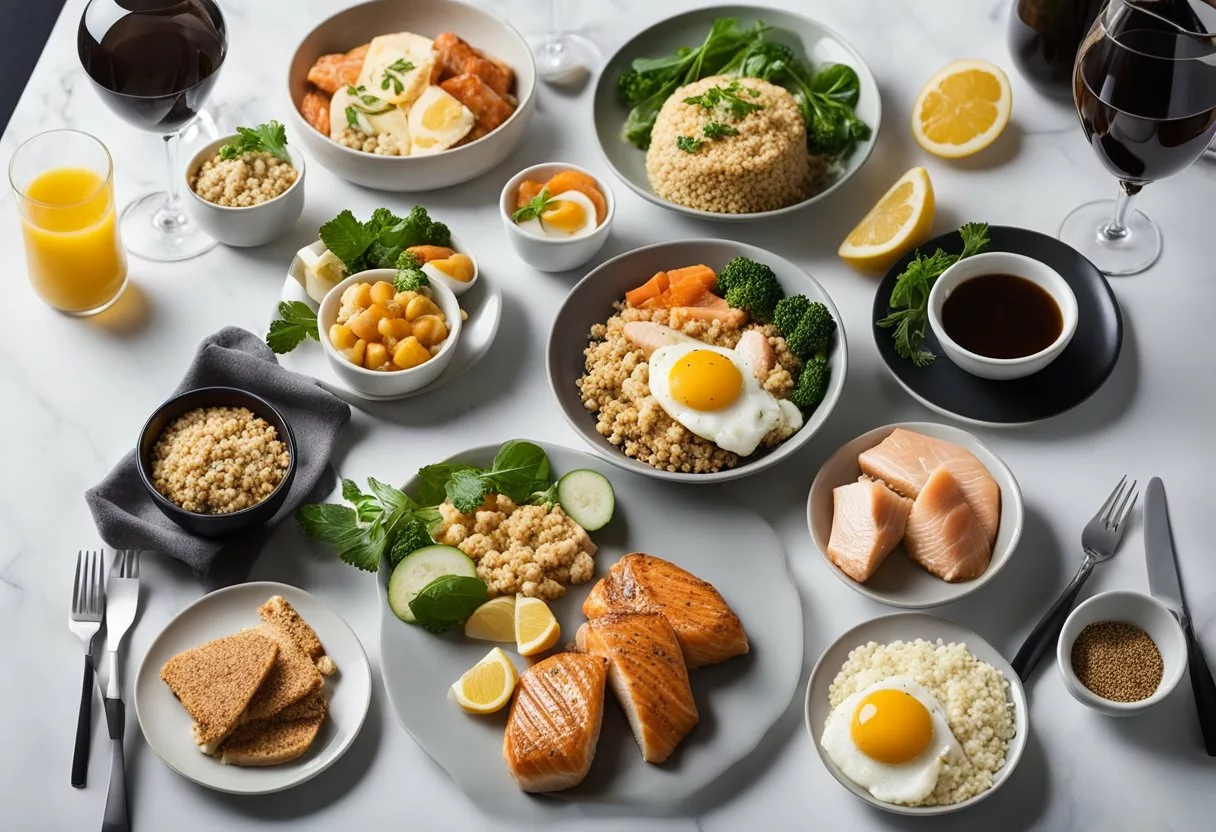
The range of high-protein foods includes both animal and plant-based sources, catering to diverse dietary preferences and restrictions. Animal-based protein, like chicken breast, lean beef, and fish, are known for their high-quality protein which contains all essential amino acids. On the other side, plant-based foods such as lentils, quinoa, nuts, and seeds are not only rich in protein but also carry other health benefits like fiber and various vitamins and minerals. Including a variety of these foods in the diet can help meet different nutritional needs and support a well-rounded diet.
Key Takeaways
- Protein is essential for numerous bodily functions, including muscle repair and immune support.
- A balanced diet can include high-protein foods from both animal and plant sources.
- High-protein diets can support body weight management and provide important nutrients.
Understanding Proteins
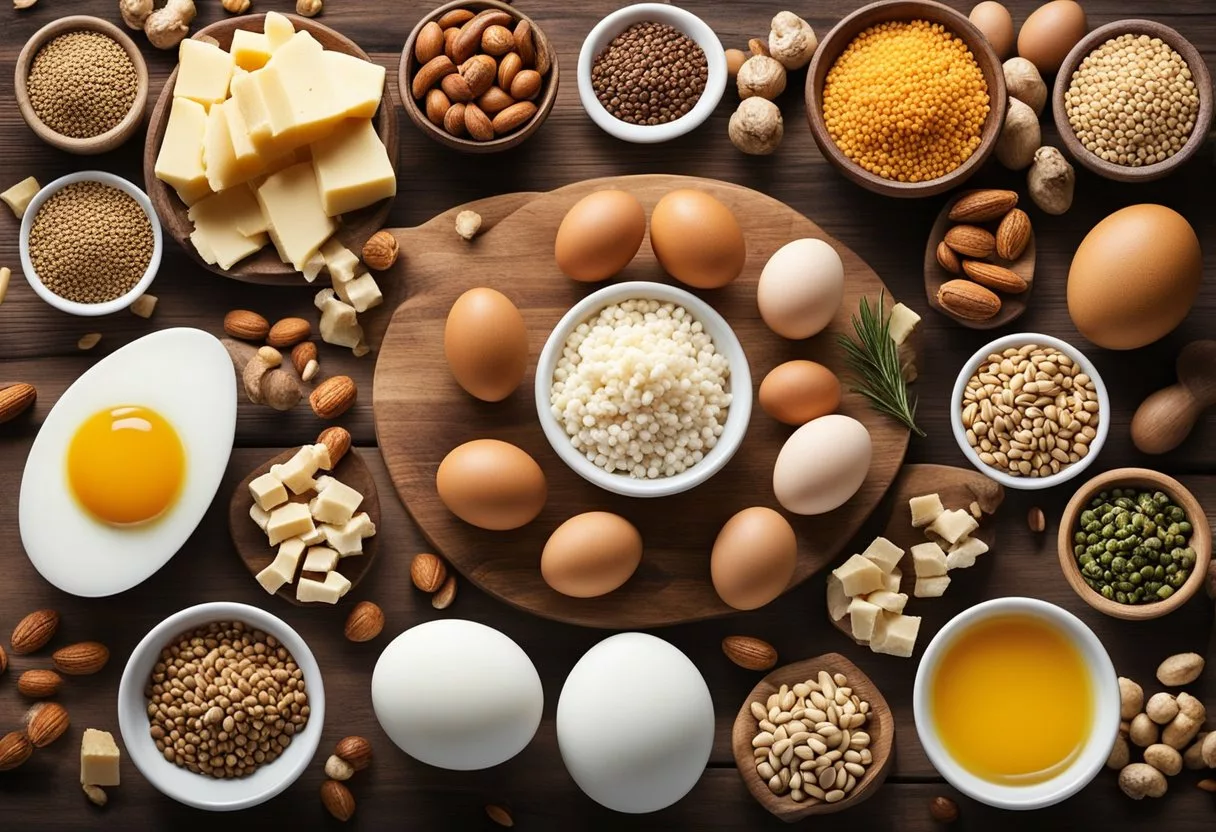
Proteins are complex molecules crucial for the structure and function of cells in the body. They are essential for maintaining muscle mass, regulating hormones, and supporting the immune system.
Role in the Body
Proteins serve numerous roles in the body; they are vital for growth and repair, act as enzymes and hormones, and are basic components of all cells. They contribute to the body’s structural integrity and are involved in virtually every cell function. Moreover, proteins play a central role in the immune system and in maintaining satiety, which helps regulate food intake. They are also important for producing energy and facilitating the actions of insulin.
Complete vs. Incomplete Proteins
Not all proteins are equal in the nutrition world. Complete proteins contain all nine essential amino acids that the human body cannot synthesize and must obtain from diet. Typically found in animal products, complete proteins provide the necessary building blocks for protein synthesis. Incomplete proteins, usually sourced from plants, lack one or more of the essential amino acids and must be combined through diet to form a complete profile.
| Complete Proteins | Incomplete Proteins |
|---|---|
| Meat | Grains |
| Fish | Nuts and Seeds |
| Dairy | Legumes |
| Some Plant-based foods | Vegetables |
Amino Acids and Their Importance
Amino acids, often referred to as the building blocks of proteins, are compounds that play many critical roles in the body. Essential amino acids, which are a subset of amino acids, cannot be made by the body and thus must be obtained from food. These amino acids are imperative for creating muscle tissue and supporting metabolic functions. They also influence the body’s energy levels and are essential for the production and regulation of hormones and enzymes.
- Essential Amino Acids:
- Histidine
- Isoleucine
- Leucine
- Lysine
- Methionine
- Phenylalanine
- Threonine
- Tryptophan
- Valine
Each amino acid has a specific role within the body, and together, they contribute to the body’s well-being by supporting metabolic processes and the body’s ability to repair itself and generate new cells.
Health Benefits of High-Protein Foods
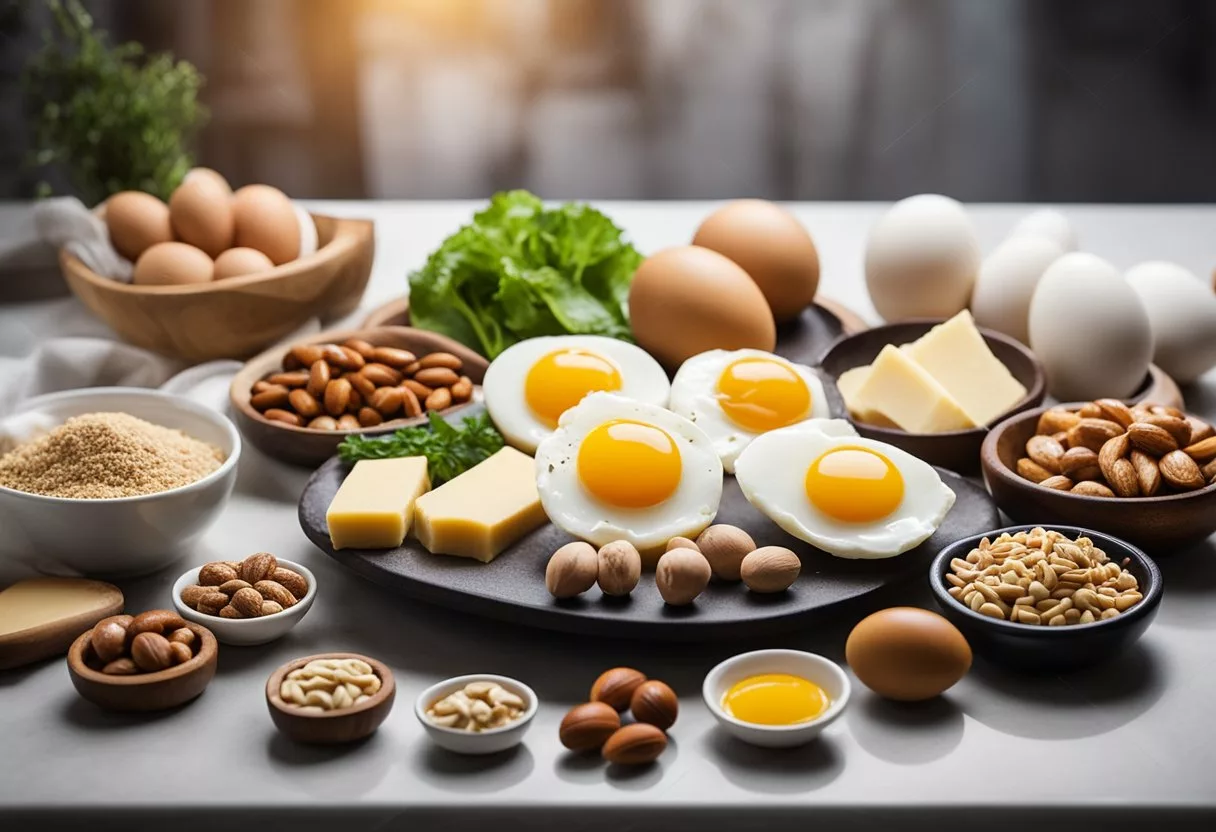
High-protein foods are instrumental in supporting a range of bodily functions from muscle repair to metabolic health. Here are some specific health benefits these foods offer.
Weight Management
High-protein diets aid in weight loss and management because protein increases satiety, meaning it helps people feel full for longer periods. This can reduce overall calorie intake. Foods rich in protein like lean meats and legumes have also been linked to a lower risk of obesity.
Muscle Growth and Maintenance
For muscle mass maintenance and growth, protein is essential. It provides the amino acids needed for muscle repair, especially after exercise. Consuming adequate protein helps maintain lean muscle tissue while promoting muscle growth and strength.
Bone Health
Proteins play a role in maintaining strong bones. Diets higher in protein support bone health by promoting calcium retention and bone metabolism. This can help prevent the onset of osteoporosis and reduce the risk of fractures.
Metabolic and Cardiovascular Health
Consuming high-protein foods can boost metabolism, aiding in burning more calories throughout the day. Additionally, when protein is consumed in place of saturated fats, there is potential for reducing the risk of heart disease. Carefully chosen protein sources can also have benefits for those with diabetes, helping to regulate blood sugar levels and potentially reducing the risk of stroke.
Best Animal-Based High-Protein Foods
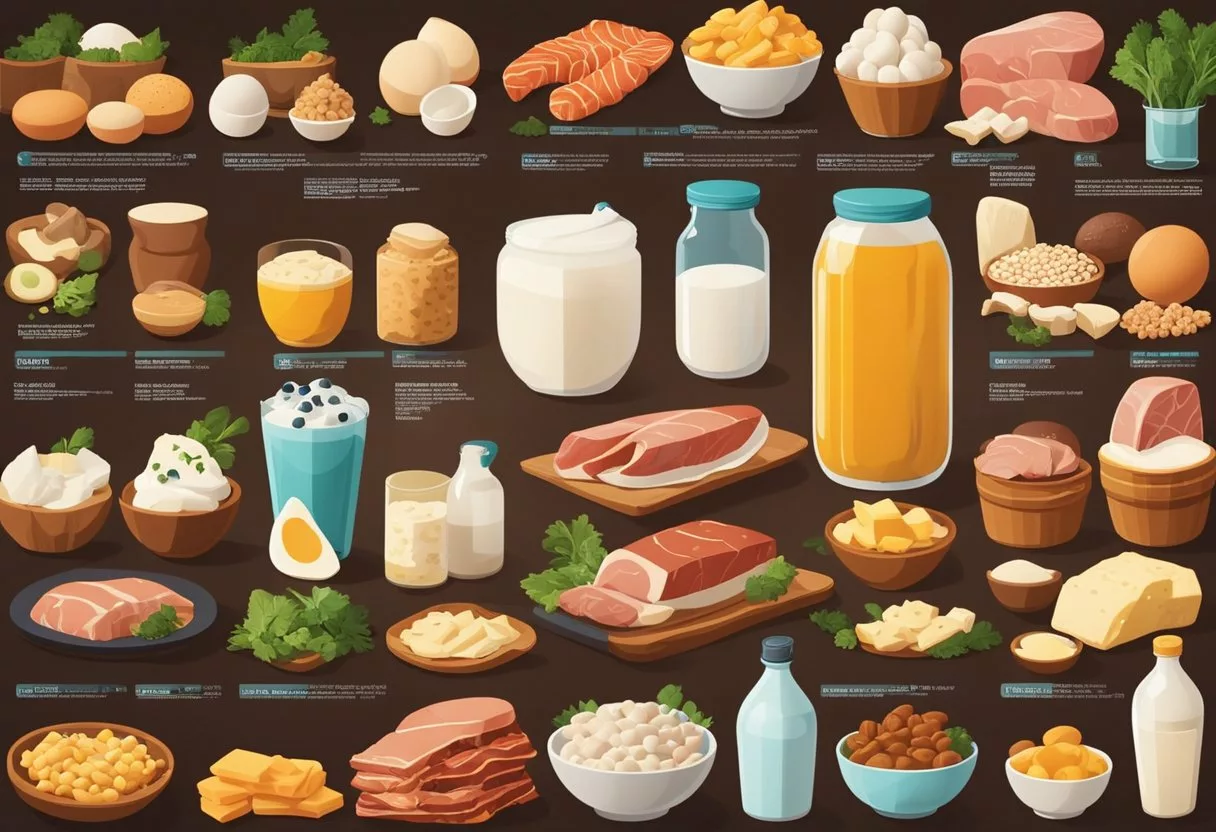
Animal-based foods are packed with high-quality protein that is essential for muscle repair and growth, maintaining a healthy immune system, and supporting various body functions. They contain all essential amino acids and are therefore considered complete proteins.
Meats
Chicken Breast
A staple in high-protein diets, chicken breast contains about 31 grams of protein per 100 grams. It’s a lean meat, meaning it’s low in fat, which makes it a great choice for those looking to build muscle without the extra calories from fat.
Beef
Beef, especially lean cuts like steak, provides a substantial amount of protein. A 100 gram serving of cooked beef steak contains roughly 25 grams of protein, along with important nutrients like iron and vitamin B12.
Pork
Pork offers variety from chops to tenderloins, with lean pork tenderloin containing about 22 grams of protein per 100 grams. It is versatile and can be prepared in numerous healthy ways.
Turkey
Turkey, especially turkey breast, is another protein-rich meat. It provides approximately 29 grams of protein per 100 grams. Turkey is often recommended as a lean substitute for higher-fat meats.
Seafood
Salmon
Salmon is not only rich in protein—about 20 grams per 100 grams—but also high in omega-3 fatty acids, contributing to heart health.
Fish
White-fleshed fish, in general, is lower in fat than any other source of animal protein, and oily fish like tuna are full of omega-3 fatty acids. Tuna offers about 23 grams of protein per 100 grams.
Dairy Products
Milk
One cup of milk contains about 8 grams of protein. It’s also an excellent source of calcium and vitamin D.
Cheese
Cheese is a versatile source of protein ranging from 10 to 25 grams of protein per 100 grams, depending on the type. Cottage cheese stands out with about 11 grams of protein per 100 grams and is lower in fat than other cheeses.
Greek Yogurt
Greek yogurt, with its rich and creamy texture, can contain up to twice the protein of regular yogurt, offering about 10 grams of protein per 100 grams.
Eggs
eggs are among the most nutritious foods on the planet, with one large egg offering roughly 6 grams of protein. They also contain a wide array of essential vitamins and minerals.
Best Plant-Based High-Protein Foods
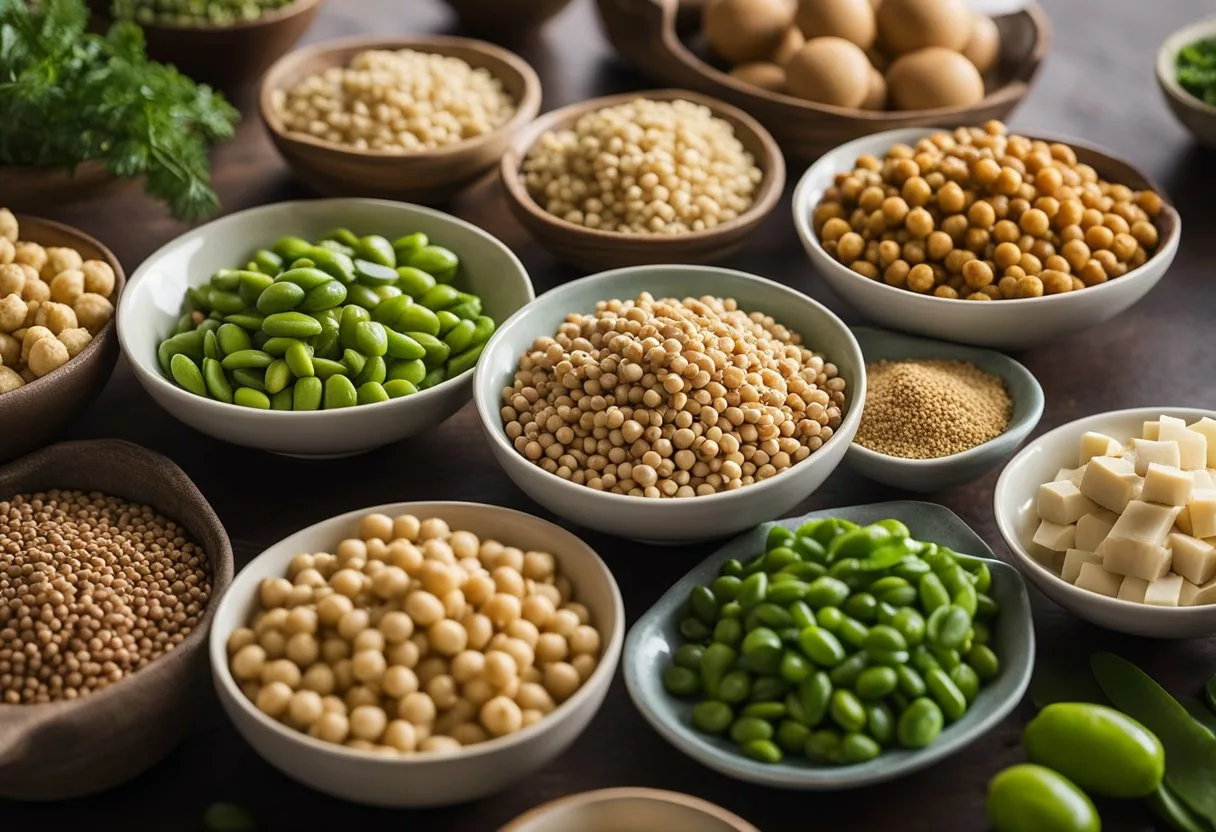
Plant-based proteins offer a plethora of nutritional benefits, including essential amino acids, fiber, and minerals. They are a sustainable alternative to animal proteins and can contribute significantly to a balanced diet.
Legumes
Legumes are a powerhouse of protein and fiber. Lentils are particularly high in protein, providing about 18 grams per cooked cup. Beans, including kidney, pinto, and black beans, are also substantial sources, alongside chickpeas and peas.
- Lentils: ~18g protein per cup
- Chickpeas: ~15g protein per cup
- Kidney beans: ~15g protein per cup
Nuts and Seeds
A variety of nuts and seeds are dense in protein. Peanuts offer about 7 grams of protein per ounce, while pumpkin seeds provide roughly the same amount. Almonds and peanut butter are also good sources, not to mention the additional healthy fats and nutrients they contain.
- Peanuts: ~7g protein per ounce
- Pumpkin seeds: ~7g protein per ounce
- Peanut butter: ~4g protein per tablespoon
Whole Grains
Quinoa stands out among grains, not only for its protein content, at about 8 grams per cooked cup, but also because it is a complete protein, meaning it contains all nine essential amino acids.
- Quinoa: ~8g protein per cup
Soy Products
Soybeans and their derivatives, such as tofu and tempeh, are among the richest plant-based protein sources. A cup of cooked soybeans contains about 29 grams of protein. Tofu can vary in protein content based on firmness, but generally offers around 10-19 grams per half-cup serving. Tempeh boasts about 18 grams per half-cup.
- Soybeans: ~29g protein per cup
- Tofu: ~10-19g protein per half-cup
- Tempeh: ~18g protein per half-cup
In summary, adding a variety of legumes, nuts and seeds, whole grains, and soy products to one’s diet can significantly enhance protein intake. These foods also come with additional health benefits, including essential vitamins and minerals.
Incorporating High-Protein Foods into Your Diet
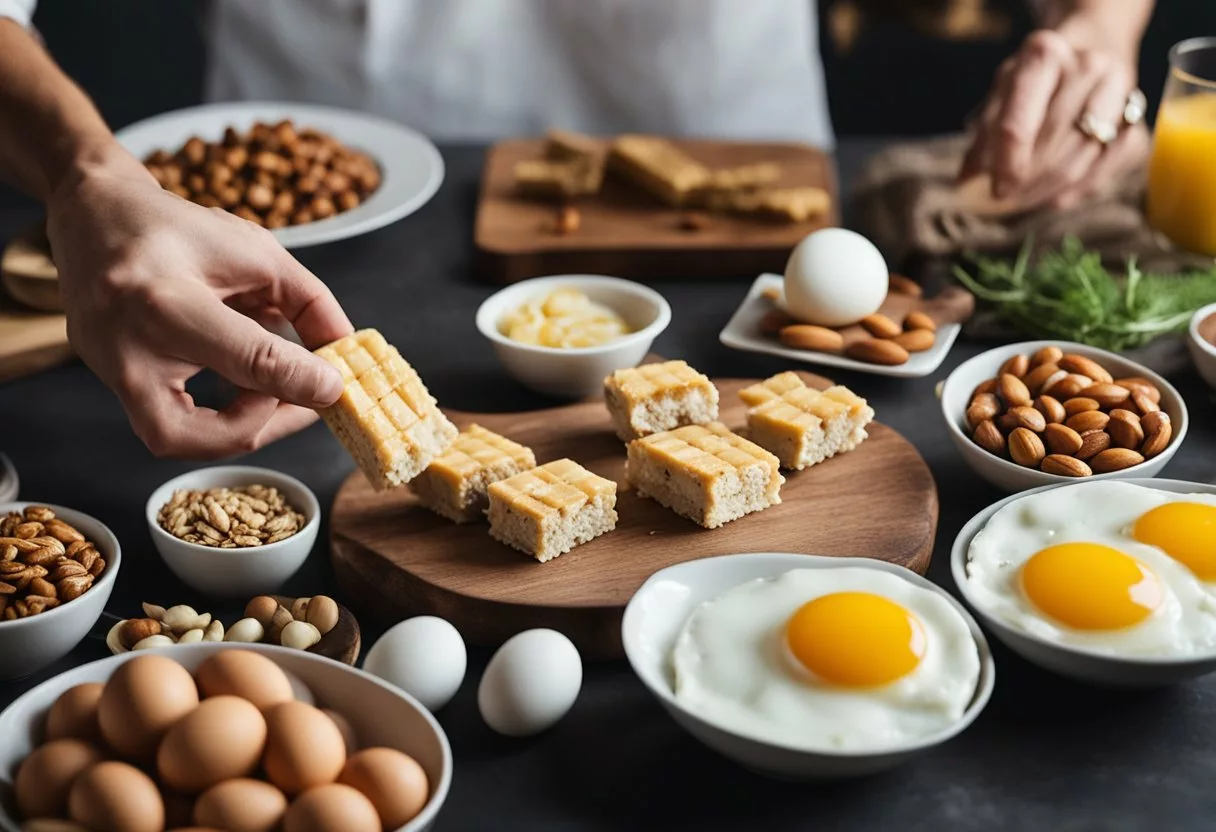
Protein is a fundamental macronutrient essential for the body’s proper functioning, from supporting cell structure to enhancing immune function. Incorporating sufficient high-protein foods into one’s diet requires careful planning and consideration of other macronutrients to maintain a balanced nutrition profile.
Meal Planning
When planning meals, individuals should be aware that the recommended dietary allowance (RDA) for protein is 0.8 grams per kilogram of body weight. For a more personalized approach, individuals may consult a dietitian. High-protein diets typically include a variety of sources like lean meats, eggs, dairy, fish, and legumes. Here is an example of how to structure a high-protein meal:
- Breakfast: Scrambled eggs with spinach and low-fat cheese
- Lunch: Grilled chicken salad with mixed greens and a vinaigrette dressing
- Dinner: Baked salmon with quinoa and steamed broccoli.
Snacks and Blended Options
Snacks are a great opportunity to boost protein intake, especially for those with an active lifestyle or for those who might not get enough during meals. Options such as nuts and yogurt can be convenient for on-the-go. Here are some protein-rich snacks:
- Nuts: Almonds, walnuts, or a trail mix
- Greek yogurt: Plain, low-fat, possibly with added fruit or seeds for extra fiber
For those needing a quick protein boost or post-workout recovery, protein powders can be used to make smoothies. A simple protein smoothie recipe could include:
- 1 scoop of protein powder
- 1 cup of low-fat milk or a dairy-free alternative
- Frozen berries for flavor and fiber
- A handful of spinach for additional nutrition.
Balancing Macronutrients
While focusing on proteins, it’s important to balance other macronutrients like fat and carbohydrates, aiming for whole-grain options and healthy fats. Diets should be low in added sugars. Here’s how to balance macronutrients in a high-protein diet:
- Fats: Opt for sources of healthy fats such as avocado, nuts, and olive oil.
- Carbohydrates: Choose fiber-rich, whole-grain breads and pastas, brown rice, and starchy vegetables.
Incorporating a variety of foods and considering prep-time and convenience will help maintain a consistent, high-protein diet contributing to overall health.
Nutritional Considerations and Potential Risks
When selecting high-protein foods, one must consider their nutritional content and potential risks associated with excessive or unbalanced intake. Vitamins, minerals, and the balance of fats are critical to the health benefits and risks of these foods.
Vitamins and Minerals Content
High-protein foods are often rich in essential nutrients, including B vitamins, zinc, selenium, and phosphorus. For example, meats such as beef or chicken are good sources of B vitamins and iron, while fish like salmon offers vitamin D and omega-3 fatty acids. Including a variety of protein sources can help ensure a balance of these nutrients. On the other hand, vegetarians and vegans can turn to legumes, nuts, and seeds, which provide proteins along with folate, magnesium, potassium, and calcium.
Managing Fat and Cholesterol
While some high-protein foods are beneficial for their saturated fat content, others can be high in unhealthy fats and cholesterol. It’s important to choose lean cuts of meat, opt for skinless poultry, and include plant-based proteins to manage fat and cholesterol intake. For example, eggs are a high-quality protein source but contain cholesterol, and therefore consumption should be moderated depending on individual health profiles.
Allergies and Intolerances
Proteins can often be the culprits in food allergies and intolerances, with some individuals reacting to proteins found in dairy, nuts, seafood, or wheat. Identification and avoidance of allergenic proteins are crucial, as reactions can range from mild to life-threatening. Plant-based proteins like soy must also be considered, as they are a common allergen.
Incorporating high-protein foods into one’s diet is a balancing act between reaping their health benefits and being aware of their associated risks and nutritional impact.
Dietary Guidelines and Recommendations
Protein intake is a cornerstone of nutritional guidelines due to its role in bodily functions and maintenance of muscle mass. These recommendations are informed by dietary allowances and specific lifestyle considerations.
Recommended Daily Allowance
The Recommended Dietary Allowance (RDA) for protein varies by age, sex, and life stage. The general guideline provided by health authorities such as the National Institutes of Health suggests adults consume 0.8 grams of protein per kilogram of body weight daily. For instance, an individual weighing 70 kilograms should aim for 56 grams of protein each day. These figures are set to meet the nutritional requirements of 97-98% of healthy individuals.
| Age Group | RDA for Protein (g/kg of body weight) |
|---|---|
| Adults | 0.8 |
| Children | 0.85-1.0 |
| Teenagers | 0.85 |
| Elderly | 1.0-1.2 |
Specific Diets and Lifestyles
Different diets, such as vegetarian and vegan lifestyles, necessitate careful planning to meet protein RDAs. Plant-based proteins are abundant but are often not complete proteins, meaning they do not contain all essential amino acids. Vegetarians and vegans should focus on a variety of sources like beans, lentils, nuts, seeds, and whole grains to ensure adequate intake. The consultation of a registered dietitian may help in tailoring a diet plan that meets all nutritional needs while adhering to the dietary restrictions of these specific lifestyles.
Myth-Busting Common Misconceptions
In this section, we address prevalent myths surrounding protein intake and its effects on health. We will clarify the relationship between protein consumption and kidney function, differentiate protein needs of athletes compared to less active individuals, and compare plant and animal sources of protein.
Protein and Kidney Damage
The myth that high-protein foods inherently cause kidney damage oversimplifies the matter. While it’s critical for individuals with pre-existing kidney disease to manage protein consumption carefully, for persons with healthy kidneys, a protein-rich diet does not automatically equate to kidney harm. However, it is important for individuals to consume balanced diets and maintain overall health to support kidney function.
Protein Needs for Athletes vs. Sedentary Individuals
Contrasting athletes with sedentary individuals, it’s a false belief that only the former benefit from increased protein intake. While athletes may require more protein to repair and build muscle after intensive workouts, sedentary individuals still need adequate protein to maintain muscle mass, support metabolism, and facilitate bodily repairs. The key distinction lies in the quantity and timing:
- Athletes: more immediate and higher quantity post exercise
- Sedentary: regular, moderate amount for daily functioning
Plant vs. Animal Protein
The debate between plant-based proteins and animal proteins often leads to the misconception that plants cannot provide all necessary amino acids. In truth, several plant sources such as quinoa and soy are complete proteins, containing all nine essential amino acids. While animal protein like red meat is a rich source, one can obtain a full amino acid profile by combining various plant sources throughout the day. This makes it entirely possible for vegetarians and vegans to meet their protein needs through diet alone.
Frequently Asked Questions
This section provides clear answers to common inquiries about incorporating high-protein foods into one’s diet.
What are healthy high-protein snack options?
Healthy high-protein snack options include a handful of almonds, Greek yogurt, a slice of turkey breast, or a hard-boiled egg. These snacks are not only rich in protein but also help in maintaining satiety between meals.
Which fruits are known for their high protein content?
While fruits are generally not high in protein, guava, avocados, and blackberries contain more protein compared to other fruits. These can be included in the diet for a slight protein boost.
Can you list high-protein foods that are also low in calories?
High-protein, low-calorie foods include lean chicken breast, turkey, legumes like lentils and chickpeas, and low-fat dairy products such as cottage cheese and skim milk.
How can one increase protein intake for weight gain purposes?
For weight gain, one can increase their protein intake by incorporating protein-rich foods like lean beef, fish, quinoa, and protein powders into their meals and snacks. It’s important to pair these with a balanced diet for healthy weight gain.
What foods should be included in a high-protein breakfast for weight loss?
A high-protein breakfast for weight loss might feature eggs, cottage cheese, or Greek yogurt, often paired with fibrous foods like vegetables and whole grains to help feel full longer and manage calorie intake.
What are some high-protein, low-carb food options?
High-protein, low-carb foods include lean meats such as chicken breast and turkey, seafood like salmon and tuna, eggs, and cheese. These options can support a diet where one aims to decrease carbohydrate intake while still maintaining adequate protein.